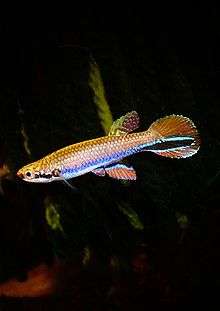Laimosemion
Laimosemion is a genus of fish in the family Rivulidae from the Amazon basin and basins in the Guiana Shield in tropical South America. They mostly inhabit small streams, creeks, swamps and pools in lowlands, but locally occur to an altitude of 1,300 m (4,300 ft).[1]
| Laimosemion | |
|---|---|
 | |
| Laimosemion xiphidius | |
| Scientific classification | |
| Kingdom: | Animalia |
| Phylum: | Chordata |
| Class: | Actinopterygii |
| Order: | Cyprinodontiformes |
| Family: | Rivulidae |
| Genus: | Laimosemion Huber, 1999 |
| Type species | |
| Rivulus geayi Vaillant, 1899 | |
| Synonyms | |
|
Owiyeye Costa, 2006 | |
Like their relatives, the adult Laimosemion often inhabit very small isolated waters, but they are not annual species like some other killifish. The adults can move some distance over land to find another water source. They do this by repeatedly flipping their body. They commonly complete their life cycle in the water, often laying their eggs among plant material. However, their eggs can survive several days of drought, only hatching when again covered by water.[2][3]
The largest are up to 8.5 cm (3.3 in) in total length, but most Laimosemion species only reach around half that size.[4]
Species
Until 2011, Laimosemion were included in Rivulus,[5] and some prefer to maintain them in that genus.[6]
If recognized as a valid genus, there are currently 29 species in Laimosemion:[4][7]
- Laimosemion agilae (Hoedeman, 1954)
- Laimosemion altivelis (Huber, 1992)
- Laimosemion amanapira (W. J. E. M. Costa, 2004)
- Laimosemion breviceps (C. H. Eigenmann, 1909)
- Laimosemion cladophorus (Huber, 1991)
- Laimosemion dibaphus (G. S. Myers, 1927)
- Laimosemion frenatus (C. H. Eigenmann, 1912)
- Laimosemion geayi (Vaillant, 1899)
- Laimosemion gransabanae (Lasso A., Taphorn & Thomerson, 1992)
- Laimosemion jauaperi W. J. E. M. Costa & Bragança, 2013[8]
- Laimosemion kirovskyi (W. J. E. M. Costa, 2004)
- Laimosemion leticia Valdesalici, 2016[9]
- Laimosemion lyricauda (Thomerson, Berkenkamp & Taphorn, 1991)
- Laimosemion mabura Valdesalici & García-Gil, 2015[10]
- Laimosemion mahdiaensis (Suijker & Collier, 2006)
- Laimosemion nicoi (Thomerson & Taphorn, 1992)
- Laimosemion paryagi Vermeulen, Suijker & Collier, 2012 (Paryag's killifish)[1]
- Laimosemion rectocaudatus (Fels & de Rham, 1981)
- Laimosemion romeri (W. J. E. M. Costa, 2003)
- Laimosemion sape (Lasso-Alcalá, Taphorn, Lasso A. & León-Mata, 2006)
- Laimosemion staecki (I. Schindler & Valdesalici, 2011)
- Laimosemion strigatus (Regan, 1912)
- Laimosemion tecminae (Thomerson, Nico & Taphorn, 1992)
- Laimosemion tomasi (Vermeulen, Valdesalici & Garcia-Gil, 2013)
- Laimosemion torrenticola (Vermeulen & Isbrücker, 2000)
- Laimosemion uakti (W. J. E. M. Costa, 2004)
- Laimosemion uatuman (W. J. E. M. Costa, 2004)
- Laimosemion ubim W. J. E. M. Costa & Lazzarotto, 2014[11]
- Laimosemion xiphidius (Huber, 1979)
References
- Vermeulen, F.B.M., Suijker, W.H. & Collier, G.E. (2012): Laimosemion paryagi (Cyprinodontiformes: Aplocheiloidei: Rivulidae), a new species from the upper Mazaruni river drainage of Western Guyana. aqua, International Journal of Ichthyology, 18 (4): 181-190.
- Furness, A.I.; D.N. Reznick; A. Tatarenkov; J.C. Avise (2018). "The evolution of diapause in Rivulus (Laimosemion)". Zoological Journal of the Linnean Society. 184 (3): 773–790. doi:10.1093/zoolinnean/zly021.
- Furness, A.I. (2016). "The evolution of an annual life cycle in killifish: adaptation to ephemeral aquatic environments through embryonic diapause". Biol Rev Camb Philos Soc. 91 (3): 796–812. doi:10.1111/brv.12194.
- Froese, Rainer and Pauly, Daniel, eds. (2018). Species of Laimosemion in FishBase. November 2018 version.
- Costa, W.J.E.M. (2011). "Phylogenetic position and taxonomic status of Anablepsoides, Atlantirivulus, Cynodonichthys, Laimosemion and Melanorivulus (Cyprinodontiformes: Rivulidae)". Ichthyological Exploration of Freshwaters. 22 (3): 233–249.
- Huber, J.H. (2012). "Reappraisal of the Phylogeny of Rivulus and its Allied focused on External Characters". Killi-Data Series. 2012: 9–25.
- Eschmeyer, W. N.; R. Fricke & R. van der Laan (eds.). "Laimosemion species". Catalog of Fishes. California Academy of Sciences. Retrieved 8 November 2018.
- Costa, W.J.E.M. & Bragança, P.H.N. (2013): A new miniature killifish of the genus Laimosemion, subgenus Owiyeye, from the Negro river drainage, Brazilian Amazon (Cyprinodontiformes: Rivulidae). Ichthyological Exploration of Freshwaters, 24 (1): 93-96.
- Valdesalici, S. (2016): Laimosemion leticia (Teleostei: Cyprinodontiformes: Rivulidae), a new species from the upper Rio Amazonas, Southern Colombia. Zootaxa, 4085 (2): 279–284.
- Valdesalici, S. & Gil, J.R.G. (2015): Laimosemion mabura, a new killifish from the Essequibo River drainage, Guyana (Cyprinodontiformes: Rivulidae). aqua, International Journal of Ichthyology, 21 (4): 166-171.
- Costa, W.J.E.M. & Lazzarotto, H. (2014): Laimosemion ubim, a new miniature killifish from the Brazilian Amazon (Teleostei: Rivulidae). Ichthyological Exploration of Freshwaters, 24 (4): 371-389.